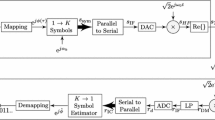Abstract
For thousands of years, humans have sought means to secretly communicate. Today, ad hoc signaling methods are used in applications as varied as digital rights management for multimedia, content identification, authentication, steganography, transaction tracking, and networking. This talk will present an information-theoretic framework for analyzing such problems and designing provably good signaling schemes. Key ingredients of the framework include models for the signals being communicated and the degradations, jammers, eavesdroppers and codebreakers that may be encountered during transmission.
Similar content being viewed by others
Author information
Authors and Affiliations
Editor information
Editors and Affiliations
Rights and permissions
Copyright information
© 2006 Springer-Verlag Berlin Heidelberg
About this paper
Cite this paper
Moulin, P. (2006). Discreet Signaling: From the Chinese Emperors to the Internet. In: Gunsel, B., Jain, A.K., Tekalp, A.M., Sankur, B. (eds) Multimedia Content Representation, Classification and Security. MRCS 2006. Lecture Notes in Computer Science, vol 4105. Springer, Berlin, Heidelberg. https://doi.org/10.1007/11848035_7
Download citation
DOI: https://doi.org/10.1007/11848035_7
Publisher Name: Springer, Berlin, Heidelberg
Print ISBN: 978-3-540-39392-4
Online ISBN: 978-3-540-39393-1
eBook Packages: Computer ScienceComputer Science (R0)




